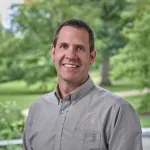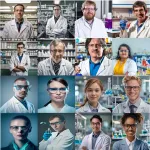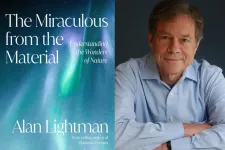(Press-News.org)
The California Institute for Regenerative Medicine (CIRM), the state’s stem cell agency, has awarded a two-year, $6 million grant to a team at the USC Dr. Allen and Charlotte Ginsburg Institute for Biomedical Therapeutics and the USC Roski Eye Institute advancing a new treatment for one of the leading causes of blindness in older adults. The funding will enable the researchers to conduct preclinical studies needed before launching human trials.
The investigators aim to accelerate progress in fighting dry age-related macular degeneration (AMD), which affects about 16 million people in the U.S. The disease is rooted in damage to the eye’s retinal pigment epithelium (RPE), the cells that support the photoreceptors of the retina. RPE cells protect, feed, and restore the rods and cones that convert light into signals readable by the brain. Dry AMD, which typically manifests in people 50 and older, is currently incurable and can eventually render those suffering legally blind.
Treatment options are presently limited to well-established vitamin supplements and newly emerged immune-regulating treatments, both of which can only slow the progression of dry AMD. The USC strategy supported by CIRM takes an entirely different approach — an injection containing a mixture of the restorative, anti-inflammatory and antioxidant compounds that are released by stem cell-derived healthy RPE.
“Nothing that’s currently out there halts or reverses the disease, and many patients end up progressing to blindness,” said principal investigator Mark Humayun, MD, PhD, University Professor of Ophthalmology and Biomedical Engineering and holder of the Keck School of Medicine of USC’s Cornelius J. Pings Chair in Biomedical Sciences. “There’s a need for a new approach. If we can develop this injection and stop disease progression or actually improve vision, that would be amazing from a patient perspective.”
The RPE secretions were derived from another dry AMD treatment developed by Humayun and his colleagues. The original therapy, which will soon enter mid-stage clinical trials, is an implantable patch of RPE cells grown from stem cells that is being commercialized by Regenerative Patch Technologies. When the researchers found that the patch was helping retinal cells far beyond its borders, they started looking into the effects of the fluid released by the patch (i.e., the secretome).
CIRM support, beginning in 2010, enabled the patch to move from preclinical development to clinical trials. Building on that success, CIRM funding then allowed the team to carefully study the promising effects of the RPE secretome, resulting in the new CIRM grant meant to again bridge research from the laboratory to early-stage tests in humans.
“CIRM has been incredibly important to this work,” said Humayun, who is the co-director of the USC Roski Eye Institute and director of the USC Ginsburg Institute for Biomedical Therapeutics. “All of this was made possible by CIRM support. California is really leading the way in stem cell research for a host of health challenges thanks to California public investment.”
The forthcoming research funded by the stem cell agency gains momentum from other steps already taken to fast-track the new treatment for clinical trials. The investigators have had a series of preliminary discussions with the Food and Drug Administration (FDA) and have identified partner testing and manufacturing facilities certified to follow good practices regulated by the FDA.
The new therapy is meant for intervention at earlier stages of dry AMD. It may play a complementary role with the patch, which addresses advanced dry AMD.
“Essentially, we get two shots on goal from the same product,” Humayun said. “If we’re successful, we can cover patients from A to Z in the continuum of their disease.”
He emphasizes the importance of another key ingredient — cross-disciplinary collaboration. Bioengineers from the USC Viterbi School of Engineering will be vital to the development of the patch, and Humayun will enlist USC Viterbi experts in artificial intelligence to maximize the healing potential of the secretome from stem cell-derived RPE.
“There are so many combinations and permutations for the genetic knobs and levers we can use, it would take forever if you just tried them sequentially,” he said. “The engineering input is critical. AI will help us better understand how to refine and improve this therapy. And as a ‘school of schools,’ USC provides a unique culture and environment for these types of interactions between disparate fields.”
Humayun, a recipient of the National Medal of Technology and Innovation, has already built an uncommon track record of success in improving care through his research. He is the lead inventor of the Argus II — also known as the “artificial retina” or the “bionic eye” — a device that has restored limited vision to hundreds who were previously blind since its FDA approval in 2013.
For this physician-researcher, the prospect of expanding the benefits he has created for patients is exciting on multiple fronts. He knows the toll of blindness all too well; his grandmother, who helped raise him, ultimately lost her sight.
“There’s no other feeling quite like when you are able to help restore sight to somebody who is blind,” Humayun said. “Professionally, you can’t ask for anything more. And on a personal note, it is deeply impactful for me given everything my grandmother meant to me.”
END
University of Delaware researchers have developed a method for mitigating the decontamination that tires release into the environment at the end of their lifespan.
In a new study published in Nature Chemical Engineering, the team demonstrated a way to upgrade 6PPD – a molecule that provides UV protection to help the rubber found in tires last longer – into safe chemicals. The method would also turn the leftover crumb rubber into aromatics and carbon black, a soot-like material found in everything from pigments to cosmetics to electronics. ...
Youth in America are experiencing a mental health crisis, according to the Centers for Disease Control and Prevention (CDC). The CDC reports that an increasing number of students are experiencing symptoms of hopelessness, depression, and anxiety, along with thoughts of self-harm.
One thing known to improve mental health among students is increased school connectedness—when students feel that the adults and peers in their school care about them as individuals in addition to their learning ability. Schools are working to improve their connectedness by adding social workers to their staff to help address the mental health concerns of students.
However, ...
The changes in society and the phenomena surrounding us are becoming more unexpected and interconnected than ever before. This increasing complexity challenges strategic management, making it harder to predict trends and developments. According to a new study from the University of Vaasa, Finland, increased complexity demands new approaches to strategic management.
– In strategic management, it is essential to acknowledge the growth of complexity and understand how to influence complexity ...
LISLE, Ill. (Nov. 20, 2024)— For the second year in a row, The Morton Arboretum’s Tree Root Biologist Luke McCormack, Ph.D., has been recognized as one of the most cited and influential researchers worldwide by global information services provider Clarivate’s esteemed annual list of “Highly Cited Researchers.”
The 2024 list, released Nov. 19, includes influential researchers at universities, research institutes and commercial organizations around the world, who have demonstrated significant and broad influence in their research field(s). McCormack, who debuted ...
A new study by researchers at the University of Galway and the University of Limerick suggests that electrical stimulation might be essential for tendons to maintain their health, offering fresh possibilities in tendon repair and regeneration.
The research took place at the CÚRAM Research Centre for Medical Devices, funded through Taighde Éireann – Research Ireland, formerly Science Foundation Ireland.
Tendons resist intense mechanical stress, while facilitating force transmission from muscles to bones. They are also piezoelectric, meaning that when they are stretched, they will produce an electric ...
CLEVELAND--University Hospitals Brain Health & Memory Center is now treating patients with KISUNLA™ (donanemab), a Food and Drug Administration-approved medication for the treatment of Alzheimer’s disease. UH is the only health system in Northeast Ohio currently offering these infusion treatments. Donanemab has shown promise in clinical trials and may be a treatment option for patients with mild cognitive impairment and mild dementia due to Alzheimer’s disease.
“People with Alzheimer’s disease have an abnormal buildup of plaques in their brain ...
Asking children “What does a scientist look like?” now results in more illustrations of women and people of color than decades ago. But do generative artificial intelligence (AI) tools also depict the diversity among scientists? Researchers reporting in the Journal of Chemical Education prompted AI image generators for portraits of chemists. They found that none of the collections accurately represents the gender, racial or disability diversity among real chemists today.
Millions of images are being created by generative AI each day. And the output of these tools is only as good as their algorithms and the initial images used to train ...
When we gaze at nature’s remarkable phenomena, we might feel a mix of awe, curiosity, and determination to understand what we are looking at. That is certainly a common response for MIT’s Alan Lightman, a trained physicist and prolific author of books about physics, science, and our understanding of the world around us.
“One of my favorite quotes from Einstein is to the effect that the most beautiful experience we can have is the mysterious,” Lightman says. “It’s the fundamental emotion that is the cradle of true art and true science.”
Lightman explores those concepts in his latest book, “The ...
Today, Nature and other Nature Portfolio journals published a collection of more than 40 peer-reviewed papers marking a milestone toward researchers’ understanding of the human body in health and disease and the development of the first draft of the Human Cell Atlas (HCA). The Human Cell Atlas is an international community whose mission is to align groups engaged in creating comprehensive reference maps of all human cells — the fundamental units of life — as a basis for understanding human health and for diagnosing, monitoring, and treating disease. The Chan Zuckerberg Initiative (CZI) is one ...
Rivers and streams serve as critical connectors across vast geographical landscapes, trickling out of tucked-away headwaters and snaking thousands of miles toward oceans and deep seas. These waterways directly impact human and environmental health, agriculture and energy production, and supply the United States with two-thirds of its drinking water. And yet, compared with other larger waterbodies, the microbiology of rivers is relatively understudied.
A Colorado State University-led team of scientists have contributed to changing that — detailing for the first time both broad and specific information ...




